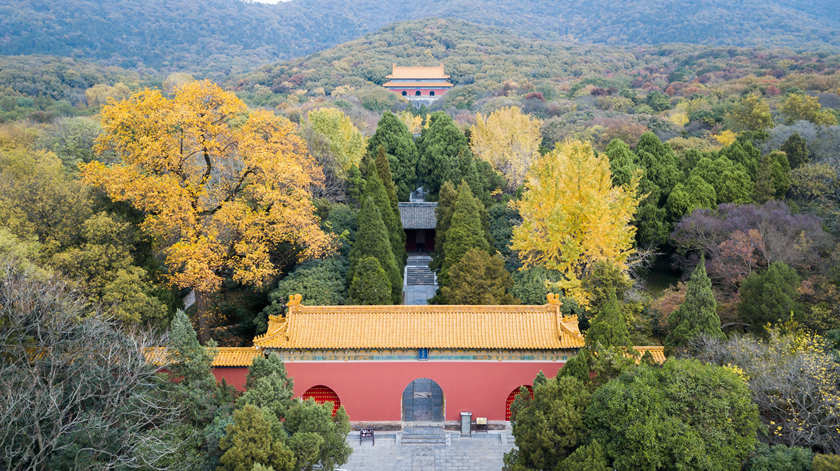Chinese Name: 明孝陵 Pronunciation: míng xiào líng
Suggested Visiting Hours: 1-2 Hours
Building Area: About 1.7 million square meters
Building Time: 1381-1405
Address: Zhongshan Scenic Spot in Xuanwu District, Nanjing.
Building Function: The Mausoleum of Zhu Yuanzhang, the first emperor of Ming Dynasty, and his wife.
Best Visiting Season: Spring and Autumn (March to May, September to November)
|
Tickets
|
Peak Season (April 1st to October 31st) |
Low Season
(November 1st to March 31st) |
|
| Admission Fee | 70 yuan | 70 yuan | |
| Joint Ticket ( including the admission fee for the Musical Stage, Meiling Palace, Ming Xiaoling Mausoleum and Linggu Temple) |
100 yuan | 100 yuan | |
Residents of Nanjing and other provinces who are over 70 years old, and children who are 6 years old (including 6 years old) or 1.4 meters (including 1.4 meters) in height, active military personnel, people with disabilities, and retired cadres of the army are admitted free of charge with valid certificates.
|
Ming Xiaoling Mausoleum
|
Peak Season (April 1st to October 31st) |
Low Season
(November 1st to March 31st) |
|
| Opening Hours | 6:30-18:00 | ||
| Ticket Office Opening Hours | 8:00-17:30 | ||
| Joint Ticket Office Opening Hours | 8:00-17:30 | ||
| Closing Time | 18:00 | ||
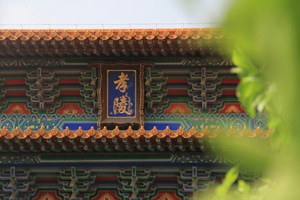
As the mausoleum of Hongwu Emperor Zhu Yuanzhang who set up the Ming Dynasty and his empress Ma, the Ming Xiaoling Mausoleum lies at the southern foot of Purple Mountain, east of the historical center of Nanjing. The Empress Ma pursued the policy of filial piety to run the country during her reign. Therefore, it was named as Xiaoling Mausoleum because “xiao” means filial in Chinese.
With the covering area of 1.7 million square meters, the Ming Xiaoling Mausoleum is one of the largest tombs in China, and its construction began in 1381 and ended in 1405 during the reign of his son, the Yongle Emperor.
Inheriting the Chinese traditional philosophic thinking that man is an integral part of nature, the mausoleum took full advantage of the natural beautiful scenery and united humanity and nature in a harmonious way, which has become an excellent example of the combination of Chinese traditional architectural culture and environmental aesthetics.
As the head of imperial tombs in Ming and Qing Dynasties of China, Ming Xiaoling Mausoleum represents the highest achievements in architecture and stone carving art in the early Ming Dynasty, and has directly affected the construction shape of more than 20 imperial tombs in the following 500 years of Ming and Qing Dynasties. For its special position in the history of the development of Chinese imperial tombs, it has won the reputation of "the First Royal Mausoleum in Ming and Qing Dynasty".
In March 1961, Ming Xiaoling Mausoleum was announced by the State Council as the first batch of national key cultural relics protection units; In 1982, it was listed as a national key scenic spot; In July 2003, the mausoleum was listed as World Cultural Heritage by UNESCO; In December, 2006, it was listed as the first national 5A-level tourist attractions.

In the 14th year of Hongwu in the Ming Dynasty (1381), Li Xin, a priest in the military governor's office, was appointed to preside over the construction of the mausoleum.
In the 15th year of Hongwu in Ming Dynasty (1382), Empress Ma died and was buried in Xiaoling Mausoleum in September.
In the 16th year of Hongwu in the Ming Dynasty (1383), the main projects such as Xiangling Hall were basically completed which expended nearly 100,000 military workers successively, and the mausoleum was completed in the third year of Yongle (1405) , and the construction of the mausoleum lasted for 25 years.
In the thirty-first year of Hongwu (1398), Zhu Yuanzhang, the Ming emperor, died and was buried in Xiaoling Mausoleum.
During Xianfeng period of Qing Dynasty, the mausoleum was almost destroyed by wars. And it was repaired by the contemporary government in 1864.
In 1961, Ming Xiaoling Mausoleum was announced as the first batch of national key cultural relics protection units.
In July 2003, at the 27th World Heritage Conference, Ming Xiaoling Mausoleum was listed in the World Heritage List as an extension project of "Imperial Tombs of the Ming and Qing Dynasties".
On June 8, 2018, Ming Xiaoling Mausoleum was selected as "Top Ten Most Popular World Heritage Sites in China".
Over more than 600 years of vicissitudes, many wooden structures of these buildings in the Ming Xiaoling Mausoleum had got destroyed for various factors, regardless of nature influences or the destruction by people. However, the mausoleum still retains the original magnificent style, and the underground tomb palace remains intact. The architecture of the mausoleum area is roughly divided into two parts: the first part is the Sacred Way, ranging from Xiamafang Gate to the main entrance of Ming Xiaoling Mausoleum; The second part is the main body, from the main entrance to Baocheng, Ming Lou and Chong Qiu.

Xiamafang Gate is a stone archway with two columns, with a width of 4.94 meters and a height of 7.85 meters. On the forehead of the gate, there are six Chinese regular script words, which indicate that ancient officials entering the mausoleum must dismount and walk to show their respect for the founding emperor Zhu Yuanzhang. Xiamafang Gate is a landmark building at the entrance of the Ming Xiaoling Mausoleum. It is also a national key cultural relic protection unit and a national 5A-level tourist attraction.
Fang Cheng is a huge building in front of Xiaoling Hall. Its exterior is made of giant strips of stone. It is 75.26 meters long from east to west, 30.94 meters wide from north to south, 16.25 meters high in front and 8.13 meters high in back. Ming Lou is above Fang Cheng, and visitors can get there by following the footpaths on the left and right sides of Fang Cheng.
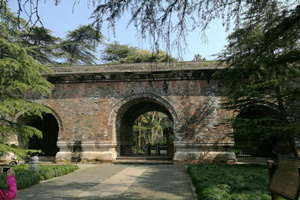
Located more than 750 meters northwest of Xiamafang Gate, Great Golden Gate (Da Jin Men ) is the first south gate of Ming Xiaoling Mausoleum. The gate was originally a yellow glazed tile double-eave building, and now there remain masonry walls, with a width of 26.66 meters and a depth of 8.09 meters. There are three doorways in the wall. The middle door is 5.05 meters high and the left and right doors are 4.25 meters high.

After entering the Great Golden Gate and walking about 70 meters to the north, a giant stone tortoise could be found, residing in the Sifangcheng Pavilion. The tortoise is 5.15 meters long, 2.54 meters wide and 2.8 meters tall. And there is a splendid carved stone stele supported by the tortoise, which is known as the "Shengong Shengde Stele". Literally, "The Stele of Godly Merit and Saintly Virtue". The stele stands 8.78 meters tall (including the tortoise) and is one of the best-known examples of its genre. The inscription of the stele was written by Hongwu Emperor’s fourth son, the Yongle Emperor, mainly extolling the merits and virtues of the Hongwu Emperor.

The Scared way is perfectly combined with the architecture and topography it lies in, presenting in a shape as S. It is an 1800-metre-long road at the Nanjing city Government site, which is near by the Sifangcheng Pavilion. The winding Sacred Way (Shenlu) includes several sections, including the Elephant Road and the Wengzhong Road.
Extending from east to northwest, the Elephant Road is lined by 12 pairs of 6 kinds of animals to guard the tomb. These animals dominate high position in ancient China and have contain rich meanings, and they are lions, xiezhi, camels, elephants, qilin, and horses. For example, as the king of animals, the lions show the stateliness of the emperor, and xiezhi, an auspicious animal in ancient China, implies integrity and justice, for it could distinguish between good and evil. At the end of the Elephant Road, the way bends due north to Lingxing Gate, with a length of 250 meters, which is called the Wengzhong Road.
Over several centuries, four pairs of stone statues of ministers and generals (or warrior guardian figures) have been standing here to guard the way to the future life. Ginkgos and maples are lined with both sides of the Scares Way, whose leaves would turn into yellow in autumn. By that time, visitors could enjoy very beautiful scenery.
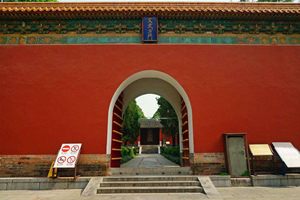
The Gate of the Civil and the Military is the main entrance of Xiaoling Mausoleum. It used to have 5 doors, and 3 arched doors in the middle and 2 rectangular doors on both sides. During the Tongzhi period of the Qing Dynasty, it was rebuilt into a doorway with the inscription "Ming Xiao Ling" in Chinese regular script. In 1999, it was restored to the original appearance of the gate in Ming Dynasty. Now there are five doors, including yellow tiles, Zhumen and red walls.

Beidian was rebuilt on the basis of the middle gate in Qing Dynasty (1644–1911) and five tall stone tablets were erected. There is a big stone tablet in the middle, which also mounted on a stone tortoise. The tablet is inscribed with 4 Chinese characters, "治隆唐宋", which were written by Kangxi, the emperor of Qing dynasty, on his third inspection tour to the South in 1699. These Chinese characters were interpreted that Zhu Yuanzhang, the founder of Ming Dynasty had made great achievements, which could match that of the founders of the Tang and Song Dynasties.

Xiaoling Hall is the main building of Xiaoling Mausoleum. The original Xiaoling Hall of Ming Dynasty was destroyed by war, and it was rebuilt in he 12th year of Tongzhi in Qing Dynasty (1873). The original hall was dedicated to Emperor Zhu Yuanzhang and Empress Ma. The existing surface building here is three small rooms, which displays some important historical materials.
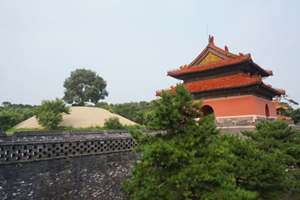
Bao Ding is a round mound with a diameter of about 400 meters. It is the underground palace where Zhu Yuanzhang and Empress Ma are buried together, with brick walls around it. There are seven Chinese characters “此山明太祖之墓” engraved on the south part of the stone wall, which were carved during the Republican Period of China. From 1998 to 1999, Nanjing Cultural Relics Bureau and other relevant departments adopted advanced precision magnetic survey, which confirmed that the underground palace of Zhu Yuanzhang's tomb was buried deep here and was well preserved.
Enter from Xiamafang Gate→Great Golden Gate→Shengong Shengde Stele→The Scared Way→Lingxing Gate→The Gate of the Civil and the Military (Wen Wu Fang Men)→The Tablet Hall (Bei Dian)→Xiaoling Hall→Fang Cheng →Ming Lou →Bao Ding
Passengers can take the city bus No.203, No.20, No.315, No.G5, special tourist line No.1,special tourist line No.2 and special line No.1, and then get off at the Ming Xiaoling Mausoleum station.
Passengers can take Metro Line 1 from Nanjing Station, and arrive at Xinjiekou Station after 5 station. Then transfer to take Metro Line 2, after passing 4 stops, and arrive at Lvyuan Station. And then passengers need to walk about 60 meters, and arrive at Weiqiao Station where they can take No.315, No.20 or take No.3 to arrive at the Ming Xiaoling Mausoleum Station.
Chinese: 请带我去明孝陵。English: Please take me to the Ming Xiaoling Mausoleum.
If you go to the Ming Xiaoling Mausoleum from the center of Nanjing by taxi, it takes about 15 minutes (about 24 yuan).
If you go to the Ming Xiaoling Mausoleum from Nanjing Lukou International Airport by taxi, it takes about 50 minutes (about 120 yuan).
If you go to the Ming Xiaoling Mausoleum from Nanjing Ma'an International Airport, it takes about 60 minutes (about 150 yuan).
If you go to the Ming Xiaoling Mausoleum from the Nanjing Railway Station by taxi, it takes about 15 minutes (about 20 yuan).
If you go to the Ming Xiaoling Mausoleum from the Nanjing South Railway Station, it takes about 28minutes (about 37 yuan).
